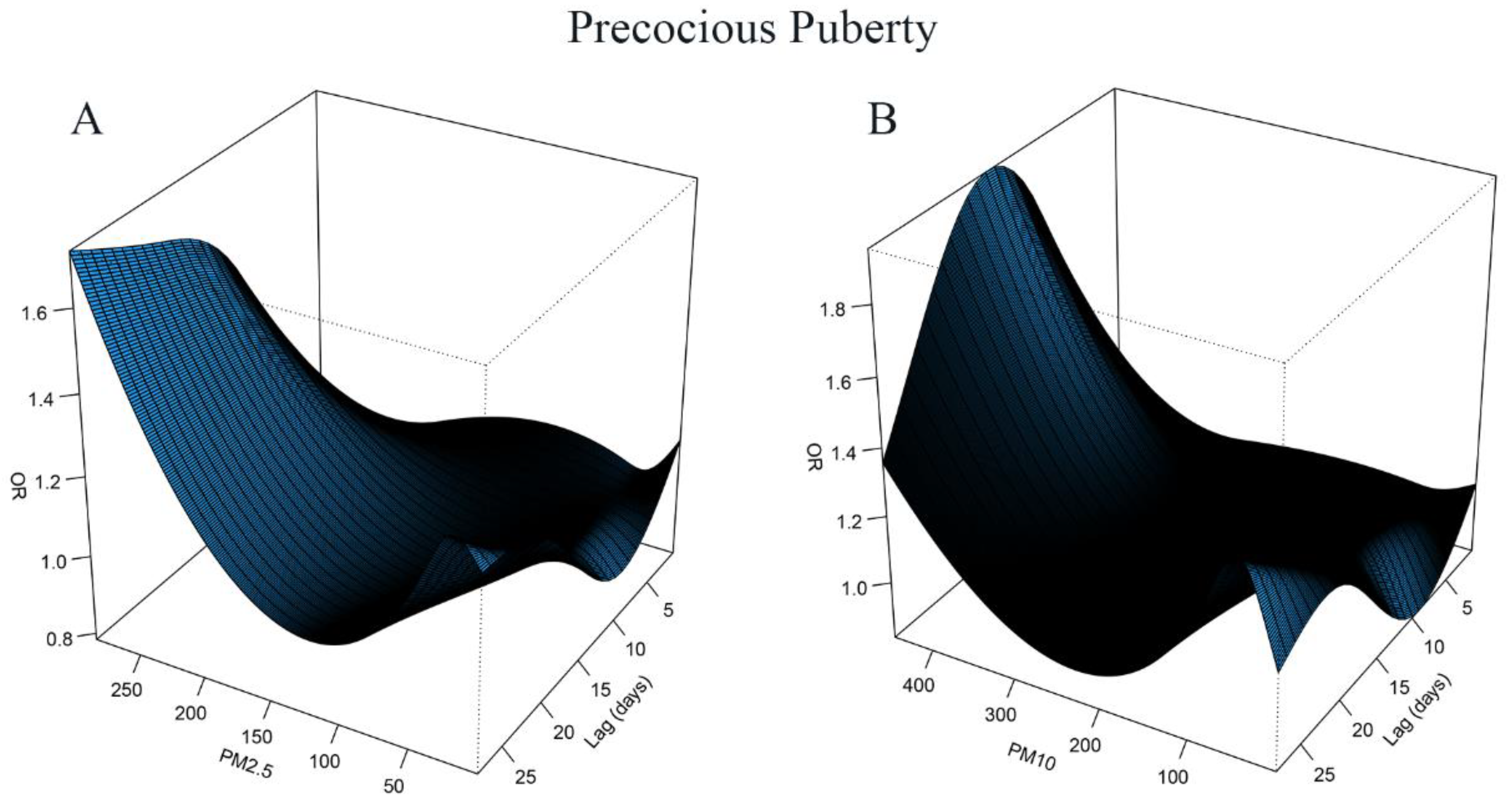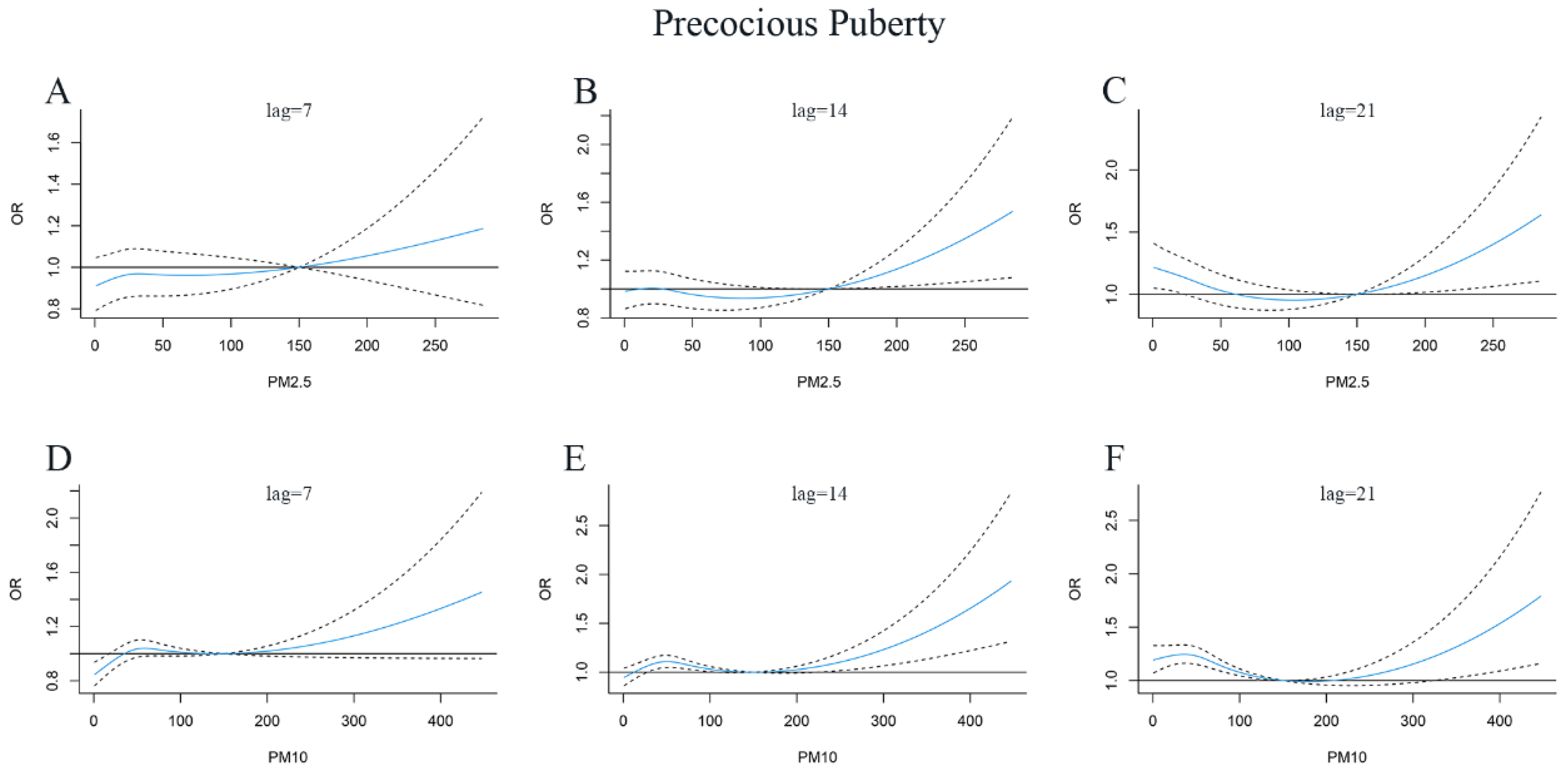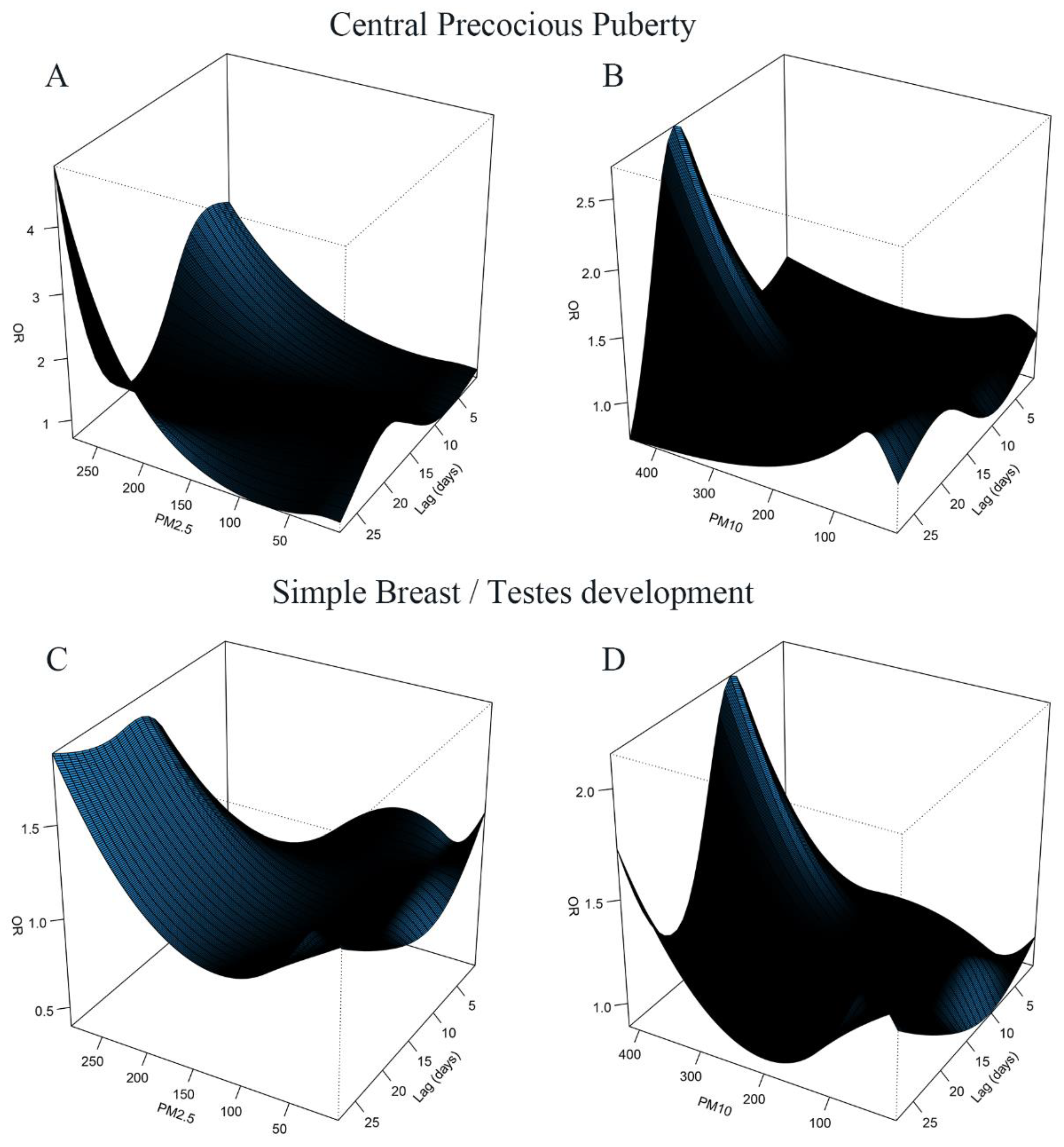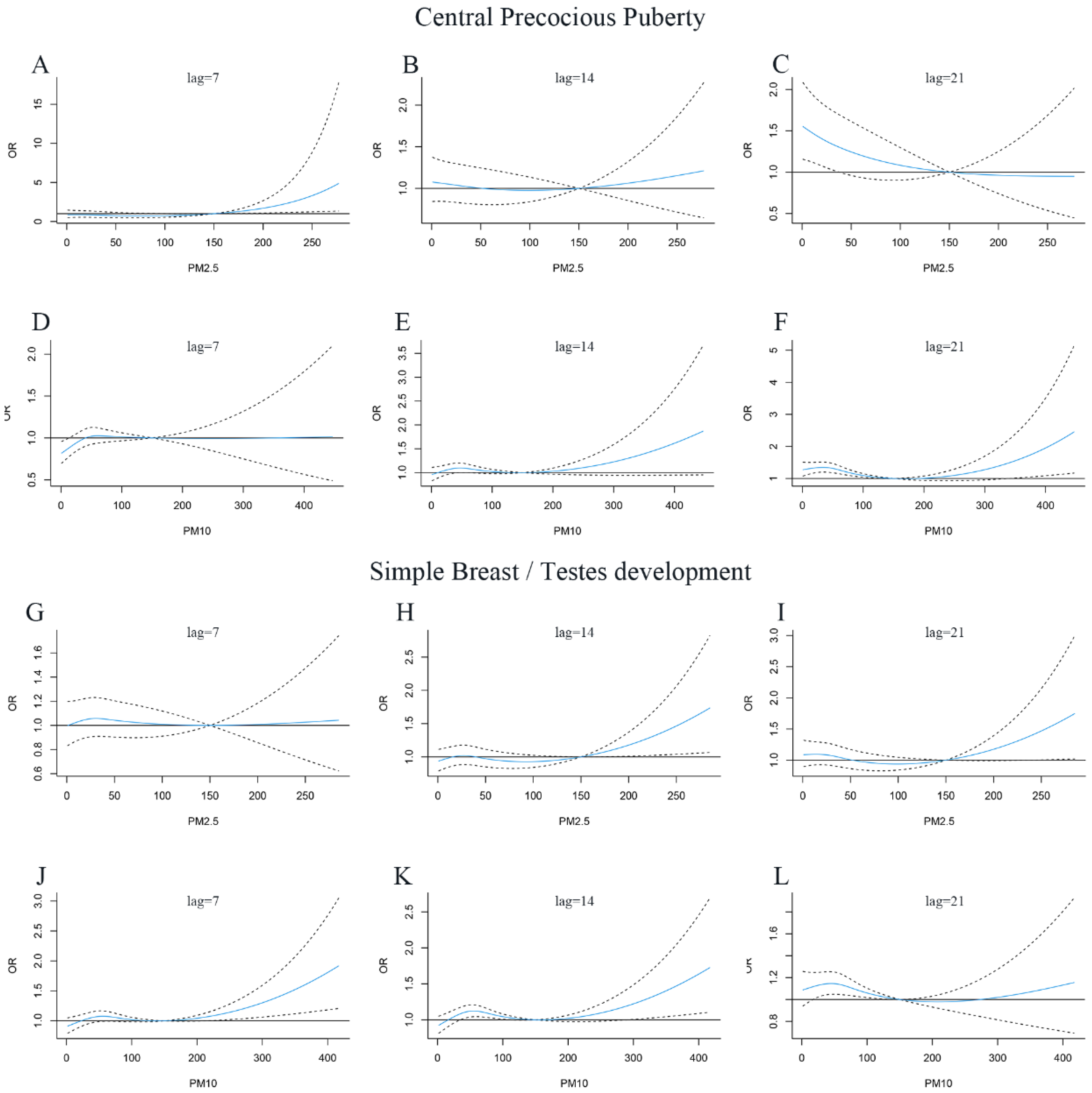Effects of Ambient Air Pollution on Precocious Puberty: A Case-Crossover Analysis in Nanjing, China
Abstract
1. Introduction
2. Methods
2.1. Study Design and Participants
2.2. Air Pollution Exposure
2.3. Measurements of Children’s Precocious Puberty
2.4. Statistical Analysis
3. Results
4. Discussion
5. Conclusions
Author Contributions
Funding
Institutional Review Board Statement
Informed Consent Statement
Data Availability Statement
Conflicts of Interest
References
- Beelen, R.; Raaschou-Nielsen, O.; Stafoggia, M.; Andersen, Z.J.; Weinmayr, G.; Hoffmann, B.; Wolf, K.; Samoli, E.; Fischer, P.; Nieuwenhuijsen, M.; et al. Effects of long-term exposure to air pollution on natural-cause mortality: An analysis of 22 European cohorts within the multicentre ESCAPE project. Lancet 2014, 383, 785–795. [Google Scholar] [CrossRef] [PubMed]
- Pun, V.C.; Tian, L.; Yu, I.T.; Kioumourtzoglou, M.A.; Qiu, H. Differential distributed lag patterns of source-specific particulate matter on respiratory emergency hospitalizations. Environ. Sci. Technol. 2015, 49, 3830–3838. [Google Scholar] [CrossRef] [PubMed]
- Zeng, X.; Xu, X.; Zheng, X.; Reponen, T.; Chen, A.; Huo, X. Heavy metals in PM2.5 and in blood, and children’s respiratory symptoms and asthma from an e-waste recycling area. Environ. Pollut. 2016, 210, 346–353. [Google Scholar] [CrossRef] [PubMed]
- Chen, F.; Lin, Z.; Chen, R.; Norback, D.; Liu, C.; Kan, H.; Deng, Q.; Huang, C.; Hu, Y.; Zou, Z.; et al. The effects of PM2.5 on asthmatic and allergic diseases or symptoms in preschool children of six Chinese cities, based on China, Children, Homes and Health (CCHH) project. Environ. Pollut. 2018, 232, 329–337. [Google Scholar] [CrossRef] [PubMed]
- Gao, H.Y.; Liu, X.L.; Lu, Y.K.; Liu, Y.H.; Hu, L.K.; Li, Y.L.; Feng, X.D.; Yan, Y.X. Short-term effects of gaseous air pollutants on outpatient visits for respiratory diseases: A case-crossover study in Baotou, China. Environ. Sci. Pollut. Res. Int. 2022, 29, 49937–49946. [Google Scholar] [CrossRef]
- Manisalidis, I.; Stavropoulou, E.; Stavropoulos, A.; Bezirtzoglou, E. Environmental and Health Impacts of Air Pollution: A Review. Front. Public Health 2020, 8, 14. [Google Scholar] [CrossRef] [PubMed]
- Veras, M.M.; Caldini, E.G.; Dolhnikoff, M.; Saldiva, P.H. Air pollution and effects on reproductive-system functions globally with particular emphasis on the Brazilian population. J. Toxicol. Environ. Health. Part B Crit. Rev. 2010, 13, 1–15. [Google Scholar] [CrossRef]
- Kumar, S.; Sharma, A.; Thaker, R. Air pollutants and impairments of male reproductive health-an overview. Rev. Environ. Health 2021, 36, 565–575. [Google Scholar] [CrossRef]
- Zhao, T.; Triebner, K.; Markevych, I.; Standl, M.; Altug, H.; de Hoogh, K.; Schikowski, T.; Berdel, D.; Koletzko, S.; Bauer, C.P.; et al. Outdoor air pollution and hormone-assessed pubertal development in children: Results from the GINIplus and LISA birth cohorts. Environ. Int. 2021, 152, 106476. [Google Scholar] [CrossRef]
- Janssen, B.G.; Saenen, N.D.; Roels, H.A.; Madhloum, N.; Gyselaers, W.; Lefebvre, W.; Penders, J.; Vanpoucke, C.; Vrijens, K.; Nawrot, T.S. Fetal Thyroid Function, Birth Weight, and in Utero Exposure to Fine Particle Air Pollution: A Birth Cohort Study. Environ. Health Perspect. 2017, 125, 699–705. [Google Scholar] [CrossRef]
- Marks, K.J.; Howards, P.P.; Smarr, M.M.; Flanders, W.D.; Northstone, K.; Daniel, J.H.; Calafat, A.M.; Sjödin, A.; Marcus, M.; Hartman, T.J. Prenatal exposure to mixtures of persistent endocrine disrupting chemicals and early menarche in a population-based cohort of British girls. Environ. Pollut. 2021, 276, 116705. [Google Scholar] [CrossRef] [PubMed]
- Huang, J.V.; Leung, G.M.; Schooling, C.M. The Association of Air Pollution With Pubertal Development: Evidence From Hong Kong’s “Children of 1997” Birth Cohort. Am. J. Epidemiol. 2017, 185, 914–923. [Google Scholar] [CrossRef] [PubMed]
- Andersen, Z.J.; Stafoggia, M.; Weinmayr, G.; Pedersen, M.; Galassi, C.; Jorgensen, J.T.; Oudin, A.; Forsberg, B.; Olsson, D.; Oftedal, B.; et al. Long-Term Exposure to Ambient Air Pollution and Incidence of Postmenopausal Breast Cancer in 15 European Cohorts within the ESCAPE Project. Environ. Health Perspect 2017, 125, 107005. [Google Scholar] [CrossRef] [PubMed]
- Mahalingaiah, S.; Missmer, S.E.; Cheng, J.J.; Chavarro, J.; Laden, F.; Hart, J.E. Perimenarchal air pollution exposure and menstrual disorders. Hum. Reprod. 2018, 33, 512–519. [Google Scholar] [CrossRef] [PubMed]
- Qiao, P.; Lei, M.; Yang, S.; Yang, J.; Guo, G.; Zhou, X. Comparing ordinary kriging and inverse distance weighting for soil as pollution in Beijing. Environ. Sci. Pollut Res. Int. 2018, 25, 15597–15608. [Google Scholar] [CrossRef]
- Zeft, A.S.; Burns, J.C.; Yeung, R.S.; McCrindle, B.W.; Newburger, J.W.; Dominguez, S.R.; Anderson, M.S.; Arrington, C.; Shulman, S.T.; Yoon, J.; et al. Kawasaki Disease and Exposure to Fine Particulate Air Pollution. J. Pediatr. 2016, 177, 179–183.e1. [Google Scholar] [CrossRef]
- Janes, H.; Sheppard, L.; Lumley, T. Case-crossover analyses of air pollution exposure data: Referent selection strategies and their implications for bias. Epidemiology 2005, 16, 717–726. [Google Scholar] [CrossRef]
- Wu, Y.; Li, S.; Guo, Y. Space-Time-Stratified Case-Crossover Design in Environmental Epidemiology Study. Health Data Sci. 2021, 2021, 9870798. [Google Scholar] [CrossRef]
- Gasparrini, A. Distributed Lag Linear and Non-Linear Models in R: The Package dlnm. J. Stat. Softw. 2011, 43, 1–20. [Google Scholar] [CrossRef]
- Gasparrini, A.; Armstrong, B.; Kenward, M.G. Distributed lag non-linear models. Stat. Med. 2010, 29, 2224–2234. [Google Scholar] [CrossRef]
- Liu, Y.; Yu, T.; Li, X.; Pan, D.; Lai, X.; Chen, Y.; Wang, X.; Yu, X.; Fu, S.; Huang, S.; et al. Prevalence of precocious puberty among Chinese children: A school population-based study. Endocrine 2021, 72, 573–581. [Google Scholar] [CrossRef]
- Zou, C.C.; Liang, L.; Dong, G.P.; Zhao, Z.Y. Peripheral precocious puberty: A retrospective study for six years in Hangzhou, China. J. Paediatr. Child Health 2008, 44, 415–418. [Google Scholar] [CrossRef]
- Chen, C.; Zhang, Y.; Sun, W.; Chen, Y.; Jiang, Y.; Song, Y.; Lin, Q.; Zhu, L.; Zhu, Q.; Wang, X.; et al. Investigating the relationship between precocious puberty and obesity: A cross-sectional study in Shanghai, China. BMJ Open 2017, 7, e014004. [Google Scholar] [CrossRef]
- Bradley, S.H.; Lawrence, N.; Steele, C.; Mohamed, Z. Precocious puberty. BMJ (Clin. Res. Ed.) 2020, 368, l6597. [Google Scholar] [CrossRef]
- Carel, J.C.; Léger, J. Clinical practice. Precocious puberty. N. Engl. J. Med. 2008, 358, 2366–2377. [Google Scholar] [CrossRef]
- Fu, J.; Zhang, J.; Chen, R.; Ma, X.; Wang, C.; Chen, L.; Liang, Y.; Luo, X.; Yang, Y.; Xiong, F.; et al. Long-Term Outcomes of Treatments for Central Precocious Puberty or Early and Fast Puberty in Chinese Girls. J. Clin. Endocrinol. Metab. 2020, 105, 705–715. [Google Scholar] [CrossRef]
- Rajsić, S.F.; Tasić, M.D.; Novaković, V.T.; Tomasević, M.N. First assessment of the PM10 and PM2.5 particulate level in the ambient air of Belgrade city. Environ. Sci. Pollut. Res. Int. 2004, 11, 158–164. [Google Scholar] [CrossRef]
- Bell, M.L.; Ebisu, K.; Leaderer, B.P.; Gent, J.F.; Lee, H.J.; Koutrakis, P.; Wang, Y.; Dominici, F.; Peng, R.D. Associations of PM2.5 constituents and sources with hospital admissions: Analysis of four counties in Connecticut and Massachusetts (USA) for persons ≥ 65 years of age. Environ. Health Perspect. 2014, 122, 138–144. [Google Scholar] [CrossRef]
- Han, B.; Hu, L.W.; Bai, Z. Human Exposure Assessment for Air Pollution. Adv. Exp. Med. Biol. 2017, 1017, 27–57. [Google Scholar] [CrossRef]
- Brokamp, C.; Brandt, E.B.; Ryan, P.H. Assessing exposure to outdoor air pollution for epidemiological studies: Model-based and personal sampling strategies. J. Allergy Clin. Immunol. 2019, 143, 2002–2006. [Google Scholar] [CrossRef]
- Breysse, P.N.; Buckley, T.J.; Williams, D.; Beck, C.M.; Jo, S.J.; Merriman, B.; Kanchanaraksa, S.; Swartz, L.J.; Callahan, K.A.; Butz, A.M.; et al. Indoor exposures to air pollutants and allergens in the homes of asthmatic children in inner-city Baltimore. Environ. Res. 2005, 98, 167–176. [Google Scholar] [CrossRef] [PubMed]
- Vardoulakis, S.; Giagloglou, E.; Steinle, S.; Davis, A.; Sleeuwenhoek, A.; Galea, K.S.; Dixon, K.; Crawford, J.O. Indoor Exposure to Selected Air Pollutants in the Home Environment: A Systematic Review. Int. J. Environ. Res. Public Health 2020, 17, 8972. [Google Scholar] [CrossRef] [PubMed]
- Zhang, Q.; Sun, S.; Sui, X.; Ding, L.; Yang, M.; Li, C.; Zhang, C.; Zhang, X.; Hao, J.; Xu, Y.; et al. Associations between weekly air pollution exposure and congenital heart disease. Sci. Total Environ. 2021, 757, 143821. [Google Scholar] [CrossRef] [PubMed]
- Jiang, F.; Wei, T.; Hu, X.; Han, Y.; Jia, J.; Pan, B.; Ni, W. The association between ambient air pollution and scarlet fever in Qingdao, China, 2014–2018: A quantitative analysis. BMC Infect. Dis. 2021, 21, 987. [Google Scholar] [CrossRef] [PubMed]
- Jung, E.M.; Kim, H.S.; Park, H.; Ye, S.; Lee, D.; Ha, E.H. Does exposure to PM10 decrease age at menarche? Environ. Int. 2018, 117, 16–21. [Google Scholar] [CrossRef]
- Wronka, I.; Kliś, K. Effect of air pollution on age at menarche in polish females, born 1993–1998. Sci. Rep. 2022, 12, 4820. [Google Scholar] [CrossRef]
- Almetwally, A.A.; Bin-Jumah, M.; Allam, A.A. Ambient air pollution and its influence on human health and welfare: An overview. Environ. Sci. Pollut. Res. Int. 2020, 27, 24815–24830. [Google Scholar] [CrossRef]
- Schraufnagel, D.E.; Balmes, J.R.; Cowl, C.T.; De Matteis, S.; Jung, S.H.; Mortimer, K.; Perez-Padilla, R.; Rice, M.B.; Riojas-Rodriguez, H.; Sood, A.; et al. Air Pollution and Noncommunicable Diseases: A Review by the Forum of International Respiratory Societies’ Environmental Committee, Part 2: Air Pollution and Organ Systems. Chest 2019, 155, 417–426. [Google Scholar] [CrossRef]
- Köksal, T.; Yalçin, S.S.; Uçartürk, S.A. Oxidant-antioxidant balance in girls with precocious puberty: A case-control study. Int. J. Environ. Health Res. 2022, 1–8. [Google Scholar] [CrossRef]
- Alderete, T.L.; Habre, R.; Toledo-Corral, C.M.; Berhane, K.; Chen, Z.; Lurmann, F.W.; Weigensberg, M.J.; Goran, M.I.; Gilliland, F.D. Longitudinal Associations Between Ambient Air Pollution With Insulin Sensitivity, β-Cell Function, and Adiposity in Los Angeles Latino Children. Diabetes 2017, 66, 1789–1796. [Google Scholar] [CrossRef]
- Wang, J.; Xie, P.; Kettrup, A.; Schramm, K.W. Inhibition of progesterone receptor activity in recombinant yeast by soot from fossil fuel combustion emissions and air particulate materials. Sci. Total Environ. 2005, 349, 120–128. [Google Scholar] [CrossRef]
- Okamura, K.; Kizu, R.; Toriba, A.; Murahashi, T.; Mizokami, A.; Burnstein, K.L.; Klinge, C.M.; Hayakawa, K. Antiandrogenic activity of extracts of diesel exhaust particles emitted from diesel-engine truck under different engine loads and speeds. Toxicology 2004, 195, 243–254. [Google Scholar] [CrossRef]
- Carré, J.; Gatimel, N.; Moreau, J.; Parinaud, J.; Léandri, R. Does air pollution play a role in infertility?: A systematic review. Environ. Health 2017, 16, 82. [Google Scholar] [CrossRef]
- Taneda, S.; Hayashi, H.; Sakata, M.; Yoshino, S.; Suzuki, A.; Sagai, M.; Mori, Y. Anti-estrogenic activity of diesel exhaust particles. Biol. Pharm. Bull. 2000, 23, 1477–1480. [Google Scholar] [CrossRef]
- Liu, C.; Yang, J.; Guan, L.; Zhu, Y.; Geng, X. Filtered air intervention reduces inflammation and hypothalamus-pituitary-adrenal axis activation in adult male and female rats after PM2.5 exposure. Environ. Sci. Pollut. Res. Int. 2020, 27, 35341–35348. [Google Scholar] [CrossRef]
- Liu, C.; Yang, J.; Du, X.; Geng, X. Filtered air intervention modulates hypothalamic-pituitary-thyroid/gonadal axes by attenuating inflammatory responses in adult rats after fine particulate matter (PM2.5) exposure. Environ. Sci. Pollut. Res. Int. 2022, 29, 74851–74860. [Google Scholar] [CrossRef]
- Qiu, L.; Chen, M.; Wang, X.; Qin, X.; Chen, S.; Qian, Y.; Liu, Z.; Cao, Q.; Ying, Z. Exposure to Concentrated Ambient PM2.5 Compromises Spermatogenesis in a Mouse Model: Role of Suppression of Hypothalamus-Pituitary-Gonads Axis. Toxicol. Sci. 2018, 162, 318–326. [Google Scholar] [CrossRef]
- Maclure, M.; Mittleman, M.A. Should we use a case-crossover design? Annu. Rev. Public Health 2000, 21, 193–221. [Google Scholar] [CrossRef]





| Precocious Puberty | Central Precocious Puberty | Simple Breast/Testes Development | |
|---|---|---|---|
| N | 2201 | 1178 | 1023 |
| Age | 7.47 ± 1.243 | 7.71 ± 1.036 | 7.19 ± 1.394 |
| Gender | |||
| Boys (%) | 74 (3.36) | 45 (3.82) | 29 (2.83) |
| Girls (%) | 2127 (96.64) | 1133 (96.18) | 994 (97.17) |
| Variable | Mean ± SD | Min | 5% | 25% | 50% | 75% | 95% | Max |
|---|---|---|---|---|---|---|---|---|
| PM2.5 (μg/m3) | 38.81 ± 26.36 | 0.04 | 11.42 | 21.52 | 32.24 | 47.88 | 89.91 | 285.75 |
| PM10 (μg/m3) | 69.77 ± 41.07 | 0.72 | 23.39 | 41.72 | 60.25 | 87.88 | 146.03 | 447.39 |
| SO2 (μg/m3) | 11.47 ± 6.76 | 1.05 | 4.10 | 6.62 | 9.76 | 14.46 | 24.82 | 110.04 |
| NO2 (μg/m3) | 39.94 ± 17.27 | 3.06 | 18.46 | 27.43 | 36.37 | 48.97 | 73.61 | 153.2 |
| CO (mg/m3) | 0.86 ± 0.31 | 0.02 | 0.45 | 0.66 | 0.81 | 1.01 | 1.43 | 7.30 |
| O3 (μg/m3) | 71.26 ± 31.43 | 3.05 | 23.55 | 48.72 | 69.46 | 90.56 | 127.97 | 250.68 |
Disclaimer/Publisher’s Note: The statements, opinions and data contained in all publications are solely those of the individual author(s) and contributor(s) and not of MDPI and/or the editor(s). MDPI and/or the editor(s) disclaim responsibility for any injury to people or property resulting from any ideas, methods, instructions or products referred to in the content. |
© 2022 by the authors. Licensee MDPI, Basel, Switzerland. This article is an open access article distributed under the terms and conditions of the Creative Commons Attribution (CC BY) license (https://creativecommons.org/licenses/by/4.0/).
Share and Cite
Yang, H.; Ge, A.; Xie, H.; Li, W.; Qin, Y.; Yang, W.; Wang, D.; Gu, W.; Wang, X. Effects of Ambient Air Pollution on Precocious Puberty: A Case-Crossover Analysis in Nanjing, China. J. Clin. Med. 2023, 12, 282. https://doi.org/10.3390/jcm12010282
Yang H, Ge A, Xie H, Li W, Qin Y, Yang W, Wang D, Gu W, Wang X. Effects of Ambient Air Pollution on Precocious Puberty: A Case-Crossover Analysis in Nanjing, China. Journal of Clinical Medicine. 2023; 12(1):282. https://doi.org/10.3390/jcm12010282
Chicago/Turabian StyleYang, Haibo, Aichen Ge, Hang Xie, Wei Li, Yizhou Qin, Wentao Yang, Dandan Wang, Wei Gu, and Xu Wang. 2023. "Effects of Ambient Air Pollution on Precocious Puberty: A Case-Crossover Analysis in Nanjing, China" Journal of Clinical Medicine 12, no. 1: 282. https://doi.org/10.3390/jcm12010282
APA StyleYang, H., Ge, A., Xie, H., Li, W., Qin, Y., Yang, W., Wang, D., Gu, W., & Wang, X. (2023). Effects of Ambient Air Pollution on Precocious Puberty: A Case-Crossover Analysis in Nanjing, China. Journal of Clinical Medicine, 12(1), 282. https://doi.org/10.3390/jcm12010282






